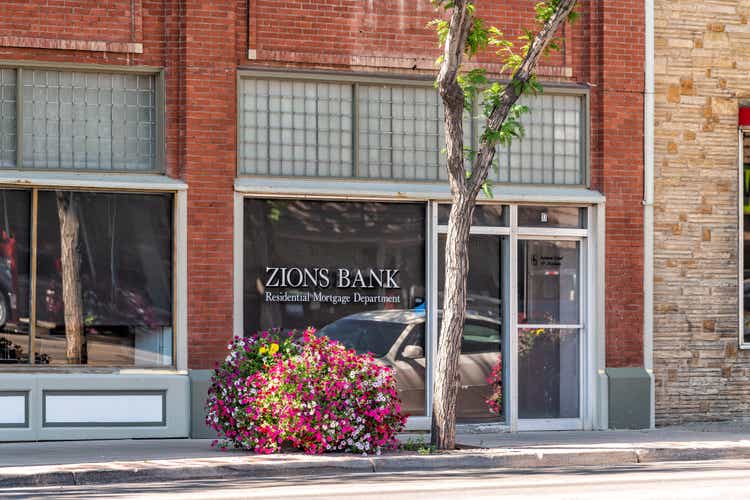krblokhin
In a difficult market for banks, the performance of Zions Bancorporation (NASDAQ:ZION) has been mixed. The shares had enjoyed a solid period of outperformance since my last update on the shares in July of 2021, outperforming regional banks by more than 30% at some points, but enthusiasm has waned as the interest rate theme plays out and Zions doesn’t look as differentiated on its growth prospects for the next phase of the cycle.
I still like Zions, but I do think the bank has work to do to convince the Street that past efforts to accelerate growth, including aggressive participation in the PPP and customer-facing IT investments, will pay off. My core growth expectations still aren’t all that aggressive though, and if Zions can unlock some sentiment drivers (better core deposit retention, better operating leverage, and so on), I could see the shares outperforming again.
Provisioning Saps Profits In Q3
Zions’ third quarter had some noise in it, but even on an adjusted basis, I wouldn’t call this a strong report for this Western bank.
Adjusted revenue rose 15% year over year and 8.5% quarter over quarter, beating expectations by about 2%. The beat was driven by net interest income, which grew 20% yoy and 12% qoq, beating by about 2% or $0.07/share. Net interest income was driven by higher net interest margin (up 56bp yoy/up 37bp qoq to 3.24%, beating by 3bp), as earning assets actually declined modestly.
Core fee income declined 3% yoy and 4% qoq but came in basically on-target with sell-side expectations. Commercial account fees were a driver here (up 18%/up 8%), as were fees from capital markets and forex (up 47%/up 19%), and card fees were positive (up 8%/up 8%) and helped to offset weaker mortgage banking and a planned reduction in overdraft fees.
Core opex increased 10% yoy and 3% qoq, coming in higher than expected in absolute terms, but pretty close on an efficiency ratio basis. Pre-provision profits rose 21% and 17% qoq but did come in a little short of expectations (about $0.015/share).
Provisioning expense was significantly higher than expected this quarter, driving $0.22 of earnings headwind relative to sell-side expectations. Management characterized the increase as “idiosyncratic” and the other credit metrics were strong in the quarter. It’s also worth noting that many banks have started to increase their provisioning in expectation of weaker economic conditions in 2023.
Loans Are Okay For Now, And Funding Is Mixed
After some recent quarters where loan performance was underwhelming, Zions beat this quarter (around 2.5%) was a welcome development. Loans rose about 3.4% qoq on an adjusted basis, beating the 2.4% qoq growth in the banking sector overall in the third quarter. The 7% qoq growth in mortgage lending isn’t sustainable, but the 4% growth in C&I lending was a solid development, while CRE lending (up 1% qoq) was softer.
Loan yields improved here, up 35bp yoy and 50bp qoq to 4.17%, which was a solid enough performance, but not a leading performance.
I’d call Zions’ performance on the funding side “mixed” given attractive costs but some concerning emergent trends. Deposits declined 4% qoq on an end-of-period basis, which was weaker than average, and the 3% qoq decline in EOP non-interest-bearing deposits (and 5% decline on an average balance basis) was not a strong result. One of the key bullish theses here has been that Zions would leverage the relationships built through PPP to lending to create a larger, stickier base of deposits from smaller commercial clients, but so far, Zions’ performance isn’t really standing out.
As far as deposit costs go, though, Zions is doing well. Total deposit costs increased only 7bp yoy and qoq (comfortably below average), and the 10bp total deposit cost for the quarter is quite low. Moreover, the bank’s cumulative deposit beta is only 3% so far, which stands out as one of the better performances in a quarter where analysts are starting to pay more attention to the likelihood of higher deposit betas through this next phase of the cycle.
The Outlook
My primary concern around Zions now is whether the bank can differentiate itself on organic growth over the next few years. Zions reaped a lot of benefit from asset sensitivity, but that impact is waning and deposit betas are going to start heading higher. That leaves loan growth, fee growth, and expense leverage as important drivers. Zions has made multiple moves aimed at driving stronger growth in the years to come, but the jury is out on how effective they’ll be, and I see a risk of weak pre-provision profit growth in FY’24 and FY’25.
The good news, relatively speaking, is that my expectations for growth at Zions weren’t that high to start with. Given the stronger rate leverage Zions has shown, my FY’25 core earnings estimate is more than 6% higher than it was last year, and I’m still looking for long-term core earnings growth in the neighborhood of 3%.
The Bottom Line
Between discounted core earnings, ROTCE-driven P/TBV, and P/E, I believe Zions shares are undervalued below $60 and priced for a long-term double-digit annualized total return. Still, the question of whether Zions can differentiate on growth is going to linger, and I don’t think we’re necessarily past the worst for bank stock sentiment yet. With that, I do think Zions is undervalued and worth consideration (especially if you have more confidence that management’s past actions will drive better growth in the coming years), but readers need to be aware of the more challenging macro environment for bank stocks now.


Be the first to comment